Crafting a Foolproof Content Marketing Workflow for Engaging Emails
Considering that for every $1 spent, email marketing generates a return of $36, it’s clear that emails are still a potent tool for multifamily. This return on investment (ROI) makes it one of the most efficient marketing strategies.
However, while its potential for reaching your target audience with personalized messages is undeniable, the sheer complexity and time-consuming nature of managing email campaigns can be overwhelming.
Enter the world of marketing automation workflows, a game-changer that has the potential to transform your multifamily business’s approach to email marketing completely. It’s more than just a time-saving technique; it’s a strategic shift that can revolutionize how you handle contacts, monitor analytics, and streamline your email marketing strategy.
Unleashing the Potential of Automation
Marketing automation is your secret weapon in taking multifamily email marketing to the next level. With dedicated software and tools like Go High Level, you can create workflows that save time and elevate the quality of your email campaigns.
With email automation, you can revolutionize your multifamily marketing approach in several key ways:
1. Automated Email Campaigns
Multifamily companies can design and schedule automated email campaigns that cater to the unique needs of their customers, investors, and partners. This automation ensures your audience receives timely and relevant updates without manual intervention.
2. Targeted Segmentation
Email automation allows for segmenting your customer and client lists based on various criteria such as interests, history, and preferences. This means that messages can be tailored to specific groups, ensuring that each person receives content that aligns with their needs. This level of personalization fosters a stronger connection between the company and its target audience, ultimately enhancing satisfaction.
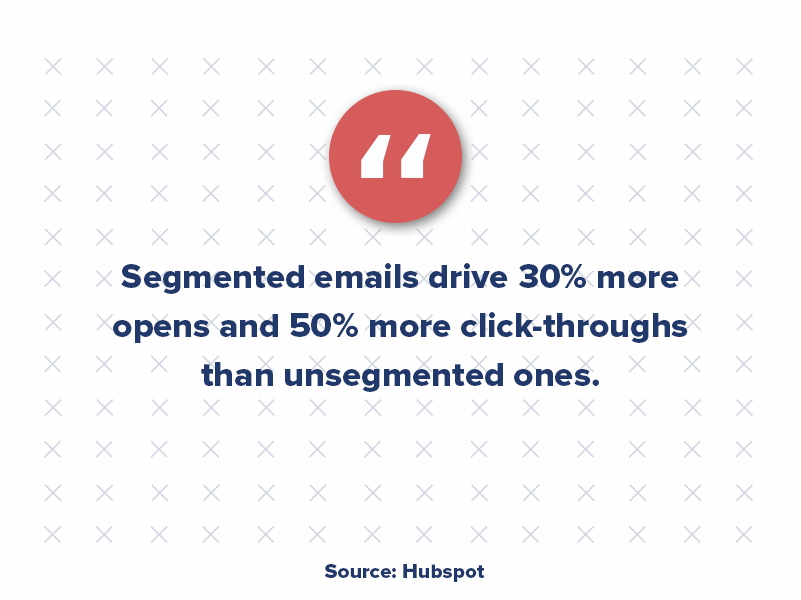
3. Enhanced Engagement
Through automated emails, multifamily companies can maintain regular engagement with their audience. These automated touchpoints inform your audience about updates, developments, and exciting opportunities. This consistent and proactive communication keeps your audience engaged and builds trust.
4. Time and Cost Savings
The power of automation lies in its ability to handle repetitive tasks efficiently. With email automation, multifamily companies can automate tasks like sending welcome emails, distributing resources, and nurturing leads. This automation not only saves valuable time but also reduces operational costs. With automated processes, companies can redirect their resources toward building and strengthening customer and client relationships.
Incorporating email automation into their strategies, multifamily companies unlock a range of benefits that enhance engagement and satisfaction and lead to substantial time and cost savings. It’s a dynamic tool that empowers these companies to operate more efficiently and effectively.
5. Monitoring Analytics in Real-Time
Marketing automation platforms provide real-time analytics to track the performance of your email campaigns. You can monitor open rates, click-through rates, conversion rates, and more. These insights empower you to make data-driven decisions and refine your strategies.
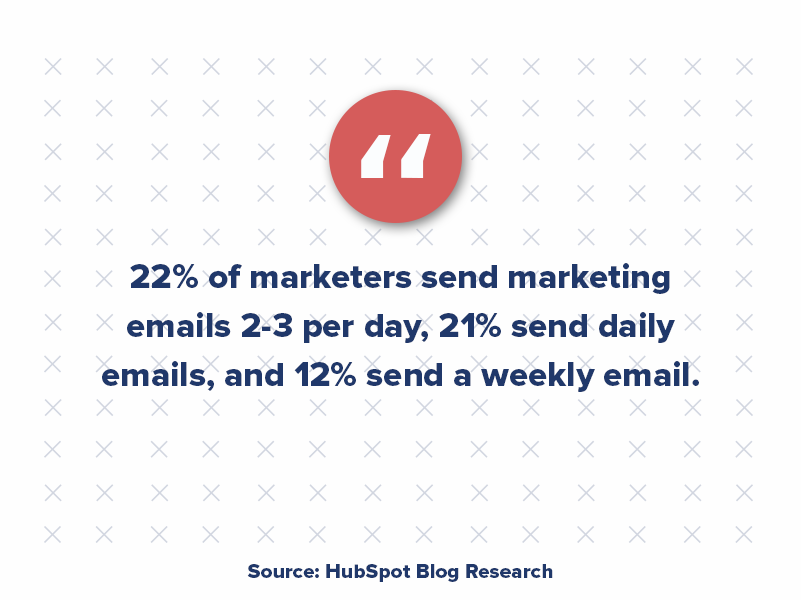
6. Never Losing Track of a Lead
Managing leads from various sources in the multifamily industry can be daunting. Marketing automation workflows automate lead nurturing. Set up drip campaigns that deliver timely and relevant content to leads, keeping them engaged and moving them through the sales funnel.
Creating a Content Marketing Workflow
Consistency is the cornerstone of effective email marketing. To ensure your emails consistently provide value to your audience, you need a well-defined content marketing workflow.
Here’s a step-by-step guide to help you create a content marketing workflow that guarantees your multifamily emails are always valuable and engaging:
Step 1: Define Your Objectives
Begin by setting clear objectives for your email marketing campaign. What are you trying to achieve with your emails? Are you aiming to educate your audience, promote new properties, or provide valuable insights into the multifamily market? Defining your objectives will guide your content creation process.
Step 2: Know Your Audience
Understanding your audience is paramount. Segment your email list based on demographics, preferences, and interests. This segmentation allows you to tailor your content to specific groups, ensuring each email resonates with its intended recipients.
Step 3: Content Ideation
Brainstorm content ideas that align with your objectives and audience segments. Consider creating a content calendar to plan your email topics and publication dates. Your content should address your multifamily investors’ and partners’ pain points and interests.
Step 4: Content Creation
Once you have your content ideas, it’s time to create them. Whether it’s informative articles, property updates, market trends, or investment opportunities, ensure your content is well-researched, engaging, and valuable. Invest in high-quality visuals and copywriting to enhance the overall quality of your emails.
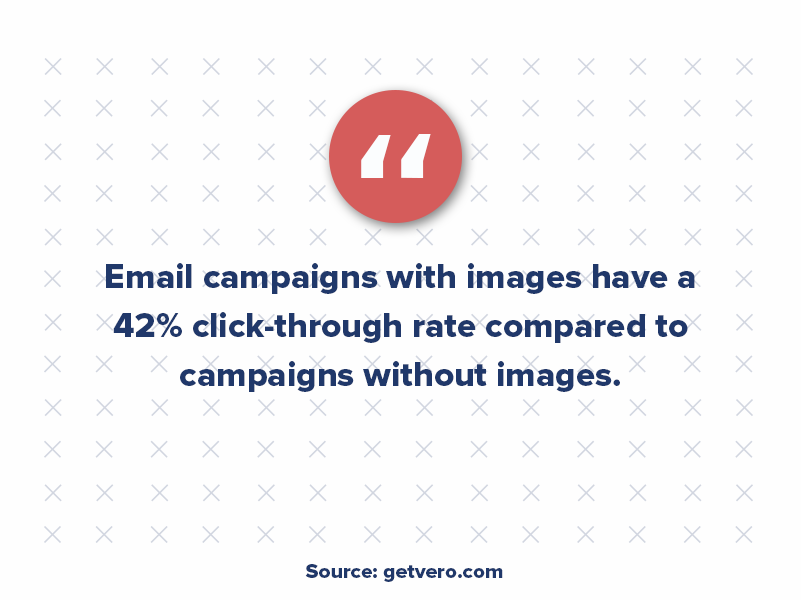
Step 5: Email Templates
Design visually appealing email templates that are mobile-responsive and user-friendly. Your templates should align with your brand’s identity and make it easy to present your content effectively. Many email marketing platforms offer customizable templates for this purpose.
Step 6: Scheduling and Automation
Set up an email schedule that aligns with your content calendar. Automation tools within your email marketing platform can help you schedule emails in advance, ensuring timely delivery to your audience. Automation also allows you to segment emails based on user actions and preferences.
Step 7: Personalization
Implement personalization tactics within your emails. Use recipient names, dynamic content, and personalized recommendations based on their past interactions with your emails. Personalization adds a human touch and increases engagement.
Step 8: Testing and Optimization
Regularly test different elements of your emails, such as subject lines, content layout, and visuals. Analyze open, click-through, and conversion rates to identify what works best for your audience. Use these insights to optimize your content and email strategies continuously.
Step 9: Reporting and Analysis
Leverage the analytics provided by your email marketing platform to track the performance of your emails. Monitor key metrics like engagement, unsubscribe rates, and conversion rates. Use this data to refine your content marketing workflow and make informed decisions.
Step 10: Feedback Loop
Encourage feedback from your audience. Provide opportunities for subscribers to share their thoughts and preferences. Use their input to fine-tune your content and ensure it consistently meets their expectations.
Which Email Automation Platform Is Best?
While numerous email marketing platforms exist, Go High Level and Hubspot are two of our favorites. This platform offers an all-in-one solution for multifamily businesses, encompassing a wide range of marketing automation tools within a single platform. This comprehensive approach simplifies your email marketing endeavors by consolidating campaign management, CRM integration, and lead tracking under one roof.
Automation is at the core of Go High Level’s capabilities. You can automate lead nurturing, follow-up sequences, and even appointment scheduling. The platform also seamlessly integrates with other tools and platforms, including CRM systems and lead generation tools, allowing you to build a cohesive marketing ecosystem.
Automation is the key to unlocking the full potential of your multifamily email marketing strategy. It’s the tool that can help you streamline your efforts, improve lead management, and deliver measurable results. By embracing marketing automation workflows and leveraging tools like Go High Level, you can elevate your email marketing services and stay ahead in the multifamily industry.
Why Apartment SEO and Multifamily PPC Are Essential for Effective Marketing
Digital multifamily marketing has evolved rapidly. While a well-designed and responsive apartment website can walk prospects through the renting process, it cannot bring them to the site independently.
Here’s where the dynamic duo search engine optimization (SEO) and multifamily PPC step in.

Diving Deeper: The Magic of SEO & PPC
Imagine you’ve started a new band and are planning your first gig. How would you let people know? Flyers are a traditional yet effective promotional method. But what if those carefully designed flyers were merely piled on a street corner, untouched?
Your multifamily website is like that flyer. It’s compelling and beautiful by itself, but how will your target audience find it?
SEO (Search Engine Optimization) – Think of SEO as strategically placing those flyers where your potential renters often visit. The ultimate aim? Climbing the ranks on search engines like Google. This is achieved by understanding your property’s unique features and aligning them with what your target audience is searching for. It’s not just about pushing your narrative; it’s about stepping into the searcher’s shoes. By understanding their needs, frustrations, and interests, you can position your brand to meet them right where they are. This process extends to your website content, blogs, social media, and back-end coding.
PPC (Pay-Per-Click) – This is a tad more aggressive. Using the band analogy, it’s like sending a band member into a popular club to hand out flyers directly to people who’d likely attend the gig. It costs more, but the results can be substantial. These ads appear prominently on search engine results. The beauty of PPC? You only pay when someone clicks to view your content.
The Synergy of SEO and PPC
Using both these methods together is where the magic happens. SEO lays the groundwork for a consistent and long-term online presence. It’s like building your band’s reputation. On the other hand, PPC can be the quick jolt of attention you need, such as announcing a debut album or a special event.
In essence, while SEO is the marathon, ensuring consistent visibility, PPC is the sprint, giving instant boosts when required. They’re integral for an effective multifamily digital marketing strategy in today’s competitive landscape.
Partners in Crime
Don’t just build a website and hope for the best. With a potent combination of SEO and PPC, backed by deep industry research and a clear understanding of your target audience, your property can stand out in the bustling apartment market. Remember, understanding your residents is a continuous journey, and it should form the backbone of all your digital marketing strategies.
Top Tips for Adding SEO and PPC to Your Campaign
Whether you are new to multifamily property marketing or looking to sharpen your approach, implementing SEO and PPC can seem daunting. However, with the right strategy, you can harness their full potential. Here are six top tips to ensure your campaign stands out:
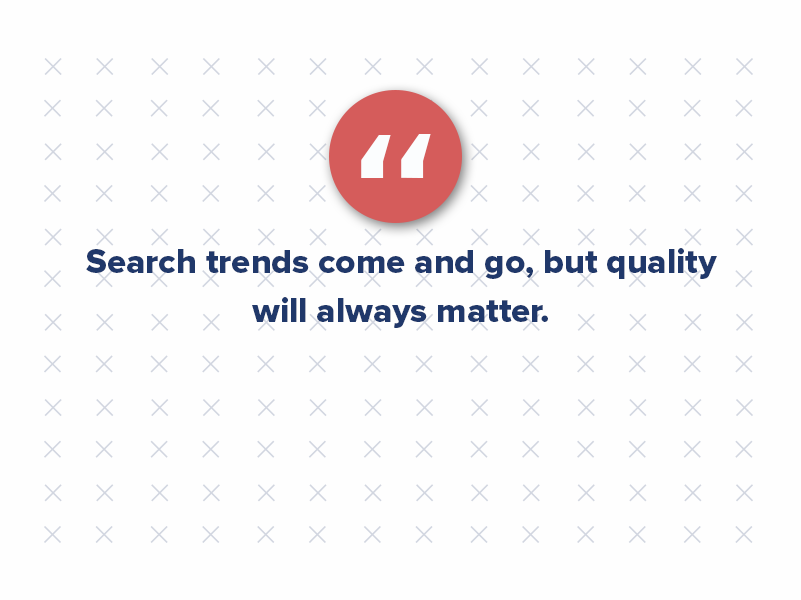
1. Prioritize Content Creation
High-quality, relevant content is the backbone of SEO. Update your website with regular blog posts, infographics, and videos that provide value to your audience. This not only increases your website’s credibility but also keeps visitors engaged.
2. Mobile Optimization Is Crucial
More users access websites from mobile devices than desktops. Ensure your multifamily property website is mobile-friendly. A responsive design, faster load times, and easy navigation can significantly improve user experience and boost your search rankings.
3. Utilize Local SEO
Most renters search for properties within their desired area. Optimize your website for local searches by claiming your Google Business Profile, gathering positive reviews, and ensuring your name, address, and phone number are consistent across all platforms.
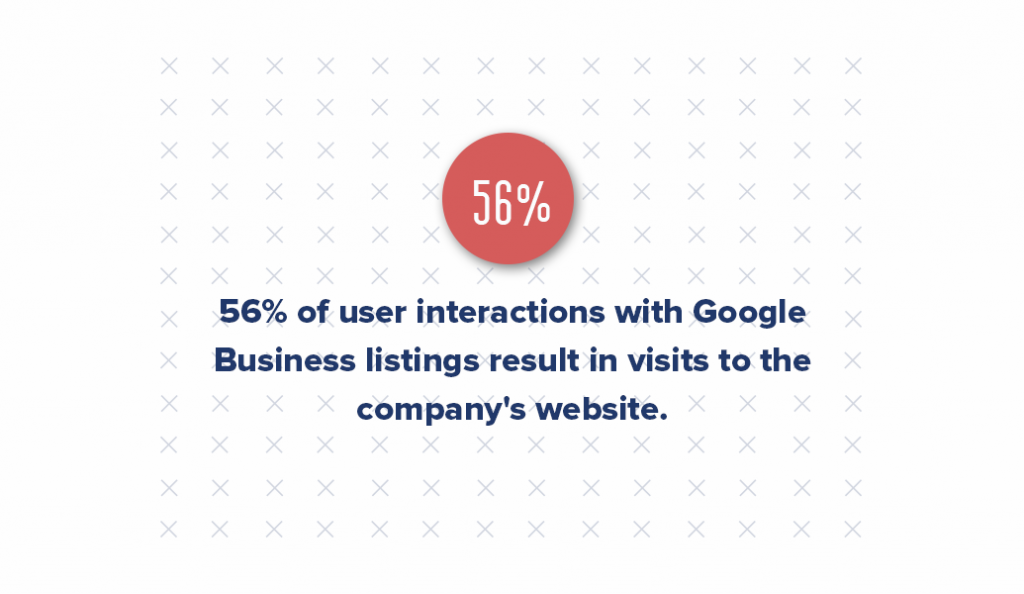
4. Use Laser-focused Targeting
The beauty of PPC is its ability to reach specific demographics. Use the insights from your market research to target specific age groups, interests, or behaviors. This ensures your ads reach those most likely to convert.
5. Regularly Test and Optimize Your Ads
Digital trends and audience preferences can shift rapidly. Regularly A/B test your ad copies, designs, and calls to action. This helps identify what resonates most with your audience and refines your approach accordingly.
6. Set Clear Campaign Objectives
Are you looking to drive immediate rentals, promote a special offer, or increase brand awareness? By setting clear objectives, you can tailor your PPC campaign, choose the right bidding strategy, and measure your success more accurately.
Two Sides of the Same Coin
Remember, SEO and PPC are two sides of the same coin. When implemented together, they can amplify each other’s results. For instance, the keywords that perform well in PPC can inform your SEO strategy. Similarly, the insights gathered from SEO analytics can guide your PPC targeting. By maintaining a cohesive approach, you can ensure a seamless and efficient multifamily marketing campaign.

Top Strategies for Effective Multifamily Lead Nurturing
Multifamily marketing professionals face unique issues with lead nurturing through the marketing funnel.
For the multifamily market, issues arise in the form of heavy competition from neighboring apartments and issues with customer retention. For developers, problems arise with a lack of awareness limiting incoming leads. For vendors, issues arise with qualifying incoming leads to ensure they are legitimate and within the proper target audience.
While many methods help generate leads, the best way to ensure continued success is to nurture your leads. Through lead nurturing, continued strategic contact can help ensure that the leads you generate are properly qualified and remain interested in your offerings.
While lead nurturing is critical to the continued marketing success of any multifamily business, most companies fall woefully behind. According to HubSpot, 65% of B2B marketers have not established lead nurturing. This is a huge missed opportunity as organizations that excel at lead nurturing generate 50% more multifamily leads at 33% lower cost.
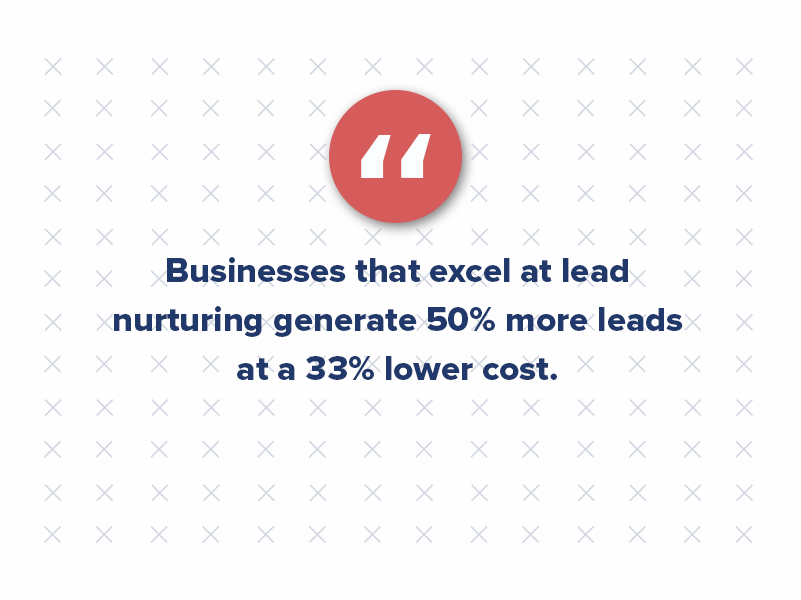
And Annuitus Group suggests that not only do companies who use automation to nurture their leads generate 451% more qualified leads but also that those leads are 47% more likely to make a larger purchase than their non-nurtured counterparts.
Knowing these numbers about lead nurturing, how many multifamily marketers miss it?
Valuing a Digital Multifamily Marketing Strategy
The commercial real estate industry is known for being behind the curve in adapting to the latest trends — especially technology. The same is true for marketing techniques.
Groups with no expertise in the industry have no idea how to use digital marketing to meet their marketing needs strategically. Partner this with a hesitancy to leave behind expensive “tried-and-true” outbound methods, and it becomes clear that commercial real estate marketers are unsure how to invest in digital multifamily marketing.
The key to robust digital marketing is to attribute value to that strategy. Many commercial real estate marketers fail to do so, hurting them in the long run.
The Advantages of Lead Nurturing
- Sustain Engagement: Keep your prospects engaged and maintain top-of-mind awareness for when they are ready to purchase.
- Guide Toward Sales: Nurture your contacts by seamlessly integrating sales messages within informative and valuable thought leadership content.
- Enhance Conversion Rates: Boost the likelihood of converting leads into sales by adopting a nurturing approach that adds value, ultimately maximizing the return on investment (ROI) for acquiring contact data.
- Prevent Lead Fatigue: Reduce the risk of overwhelming leads with aggressive sales pitches immediately after they download one of your resources. People generally prefer an educational and nurturing approach, which contributes to the success of building relationships and driving conversions.
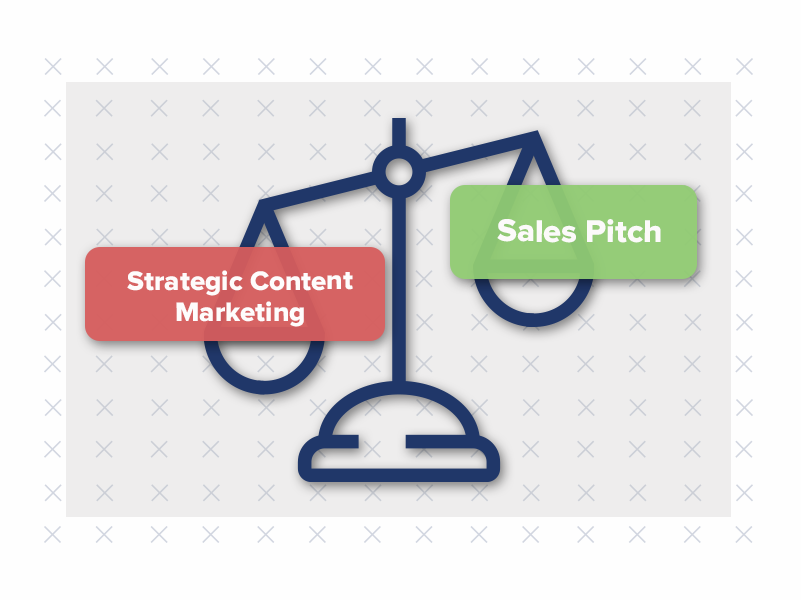
Finding a Balance
Digital marketing relies on the perfect balance of digital strategies, working together in an integrated manner to ensure consistent messaging and continued contact with an apartment lead or prospect. This means unique content — such as blogging, offers, social media content, email marketing, etc. — should all be tied around a central persona, strategy, and buyer’s journey.
Adding these aspects together and ensuring you have the team and resources to run it all adds up. However, compared to the average standard spend on outbound strategies, the cost is typically much less. In fact, inbound multifamily marketing costs 62% less than traditional marketing, yet each dollar spent on inbound marketing generates 3x as many apartment leads.
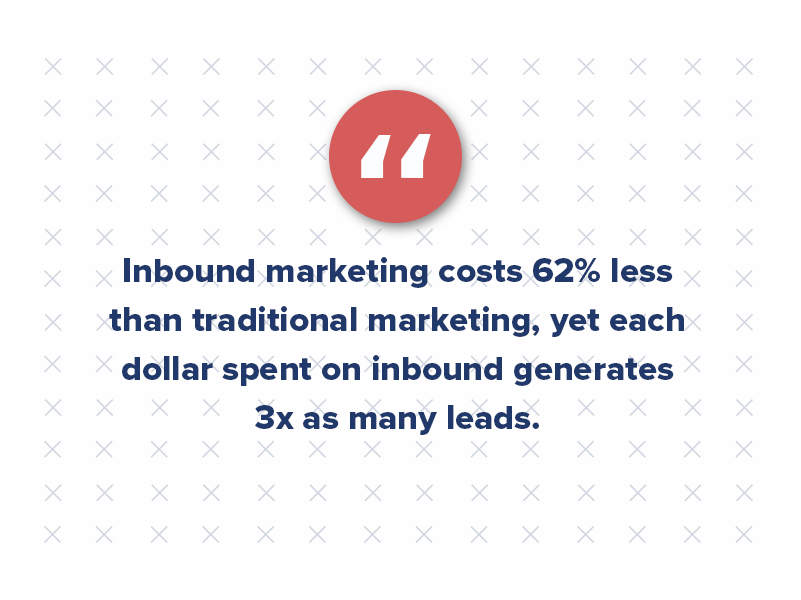
7 Types of Email Marketing Campaigns for Multifamily Lead Nurturing
Typically, when speaking of apartment lead nurturing, people instantly think of email drip campaigns. These are email campaigns automated to go out to a list over a specific period. While this can be a lead nurturing method, it is not the only method.
The fact of the matter is that many types of lead nurturing emails may be used depending on your needs. And each has a benefit or strength.
1. Welcome and Engagement Nurturing
When bringing new leads aboard, it’s wise to nurture them while they are still hot — actively interested. Capitalizing on the novelty of your introduction to them can be a great foot in the door to a positive impression. However, it’s also important not to scare away your multifamily leads by coming off as overeager. This is where a “welcome” campaign comes into place.
The benefit is two-fold: While engaging your lead with your brand, you can use this campaign to gather information to segment the lead further. Step one of a welcome campaign is always the same — you take the time to welcome your new multifamily lead and let them know what to expect. You can also offer a free resource.
Going an extra step, you can offer these leads a way to get customized information depending on their interests. This may take much work on your backend through list segmentation and automation software. But if the framework is there, it’s work that pays off. Offer a weekly newsletter on multifamily trends, interesting statistics, or relevant industry articles.
Engagement campaigns are similar and can often stem as an off-shoot of your welcome campaign. Want feedback on a certain aspect of your business? Engage a list focused on that aspect of a focus group or survey session, and motivate them to participate. In this form of nurturing, your imagination is the limit.
2. Qualification Campaigns
A qualification campaign allows you to hone in on a lead in a critical interest time. Let’s say a multifamily lead downloads a few offers in quick succession. Adding this lead to a qualification campaign lets you speak to them clearly as they try to discover the answer to their problem. Sending more related offers with opportunities to touch base with your team brings you closer to making the lead sales qualified.
3. Traditional Nurturing Campaigns
A traditional nurturing campaign takes your lead’s interest and continues to offer relevant educational material. These types of campaigns most often accompany your overall marketing strategy. This campaign includes keeping in touch with a multifamily lead, giving them small opportunities to convert.
4. Event Campaigns
Whether hosting an event online or in person, an event campaign can help pique interest and attendance. Even if you’re trying to boost attendance to your booth at an industry conference, event campaigns are a great way to spread awareness, boost interest (usually by a unique offer), offer reminders and other great tips leading to your event, and provide an excuse for strong feedback and thank you emails that can further promote conversion.
5. Promotional Campaigns
If you have some multifamily leads you feel are on the edge of closing, a promotional campaign might be a nudge in the right direction. A promotional campaign should be very controlled, not to cheapen the perceived value of your product. Discounts, free bonuses, or even referral bonuses are good ways to augment a promotional campaign.
6. Re-engagement Campaign
Do you have a lot of leads that have gone cold? Purging these leads from your lists can seem like a waste. Instead of letting these multifamily leads go, why not implement a re-engagement campaign? This includes reminding them of your value or offering them something special to engage.
7. Upsell Campaign
Don’t let the title concern you. While upsell campaigns have a negative connotation, they don’t always have to mean or reflect upselling. Rather, an upsell campaign promotes your offerings to existing customers. In some cases, this means offering additional services.
Return Is in the Eye of the Beholder
Knowing that multifamily lead nurturing is far more complex than most marketers realize, the question becomes, which form offers the best return? The answer is not so simple. While each of these nurture campaigns requires a certain amount of upfront investment, the payoff depends entirely on your business.
The question comes down to which problem you are facing the most. If your issue is moving leads down the pipeline, a qualification campaign will most benefit your needs. If you are working on reviving multifamily leads, engagement, and re-engagement campaigns should be your go-to.
Choosing a nurture campaign tied to your strategy is more important than taking a set-it-and-forget-it route. This is where you can make the most significant impact on your business. Only then will you see sustainable success in nurturing your multifamily leads.
It’s Time to Take Digital Multifamily Marketing Seriously
Most digital marketers can probably relate to this social situation: Someone asks what you do for a living. After explaining that you work in multifamily digital marketing, the inquisitor follows up with some variation: “So, you play around on Facebook all day?”

Social media for multifamily vendors and developments, in particular, gets a bad reputation, with some business owners refusing even to acknowledge social platforms as legitimate marketing channels.
But if you think digital marketing is just fluff and noise, you are missing out on low-cost campaigns with great returns on investment that traditional marketing cannot compete with. Most businesses fail to realize that digital marketing offers more measurable value than traditional methods.
How a Company Generated $2M From One Blog
Over the years, blogging has transformed from a forum for teenagers into an affordable multifamily lead generation tool. To understand how this transformation occurred, let’s first examine how the internet has changed consumer behavior.
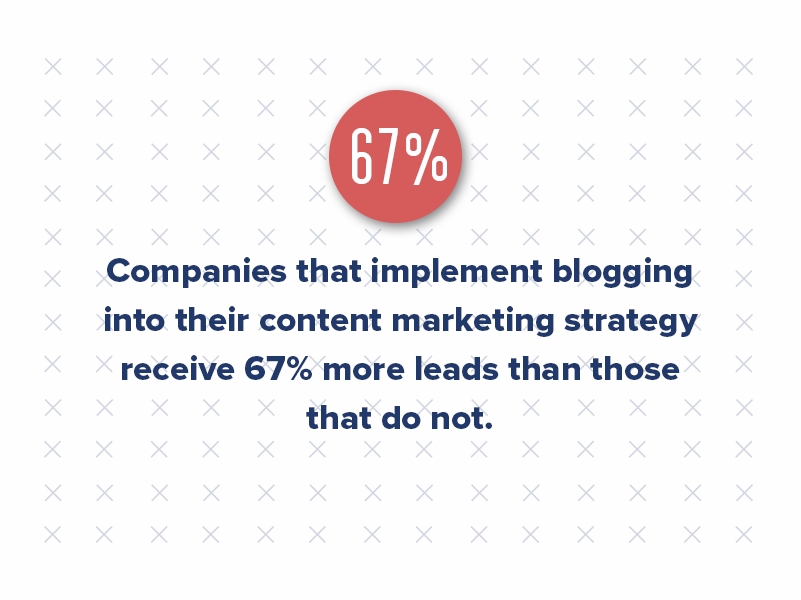
With a digital information repository at your fingertips, today’s consumers are more educated than ever. Gone are the days of visiting a store to speak to an expert or asking neighbors for referrals. Everything from pricing to reviews is found with a simple search.
No matter what industry or consumers you serve, customers have questions, and you can guess where they go for their answers — Google. So, how can you take advantage of this? By answering those questions on your company’s blog or FAQ page.
Marcus Sheridan, one of the earliest content marketing proponents, generated $2 million for River Pool & Spas when he published a blog post on the company’s website answering a simple question: “How much does a fiberglass pool cost?”
What did the blog post cost him? A half-hour of his time and maybe some web analytics tools? We’ll take that ROI.
According to Tech Client, businesses have a 434% higher chance of a high ranking on search engines if they feature blogs as part of their website. Additionally, HubSpot found that companies that implement blogging into their content marketing strategy receive 67% more leads than those that do not.
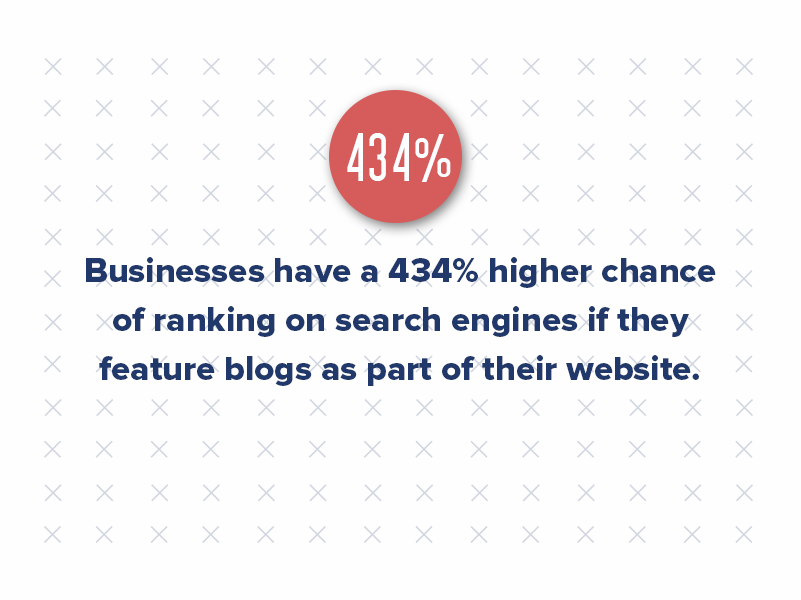
Content marketing might seem pretty straightforward, but like any marketing campaign, it is important to have a strategy. For most businesses, you are not blogging just to blog; you create content to drive your marketing funnel.
Social Media’s Biggest Value-Add for Business
Multifamily owners often ask, “Is social media a legitimate way to generate multifamily leads?” But those owners might be asking the wrong question.
The value of social media is not measured in leads, but rather, it is measured through customer experience. According to Forrester data, a relationship exists between customer experience and stock price. People are willing to pay a premium cost for the experience with a brand.
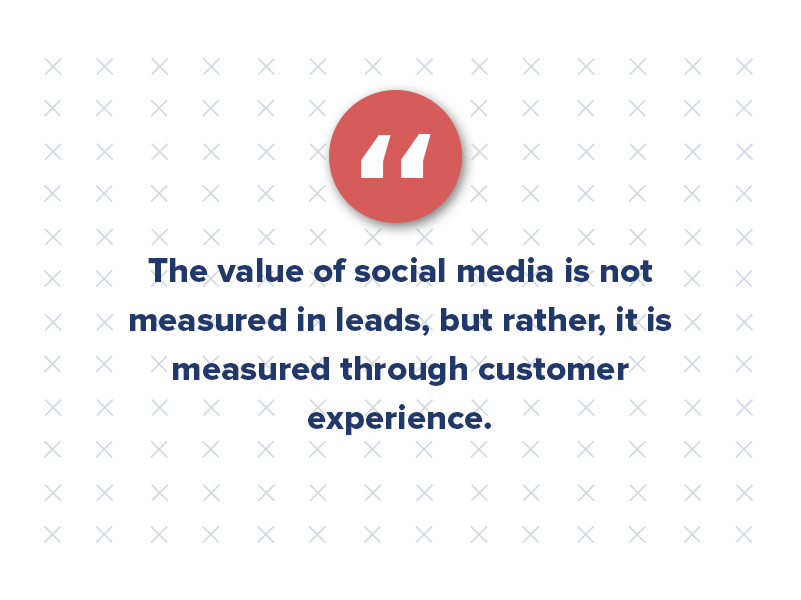
Additionally, improving customer experience can save your company big bucks. In fact, Sprint saves $1.7 billion each year by determining and mitigating the root cause of customer dissatisfaction from calls made to its contact center.
And as it turns out, social media is crucial to improving customer experience. The internet allows word-of-mouth communication to spread easier than ever, both positive and negative.
In the multifamily industry, for example, negative commentary from residents is commonly found across social media and online review sites such as Yelp, Twitter, and Google business pages. Residents who are frustrated with a property’s maintenance issues or poor customer service often express those feelings publicly online. How a multifamily property responds will determine how a negative comment affects your business.
However, each part of your marketing strategy should fit into one cohesive piece. Your website, social media presence, user experience, customer experience, etc., should work harmoniously to establish a successful inbound marketing plan.
You Must Talk Marketing ROI (4 Key Takeaways)
As marketers, we are constantly faced with the battle of justifying ourselves and our multifamily marketing agency’s role in a company’s ROI. We must always find ways to prove to CEOs that marketing contributes to the bottom line.
But how?
Here are 4 ways to convince multifamily owners and CEOS that marketing ROI matters.
1. Be relevant — set SMART goals.
Do you find yourself constantly sharing statistics that discuss retweets, follows, visits to the website, etc.?
These stats are important, but if you have not established true goals and understand how and if your work is contributing to the bottom line, STOP IT! It’s time to set up your SMART goals, communicate with your sales team, and start being relevant to what is most important to the CEO and company: ROI.
2. Play offense, not defense.
Believe it or not, about 69% of CEOs believe that marketing is a waste of time, money, and resources. To stay on the offense, you must clearly define your goals, ensure that sales and marketing are happy, and discuss the purpose behind your goals.
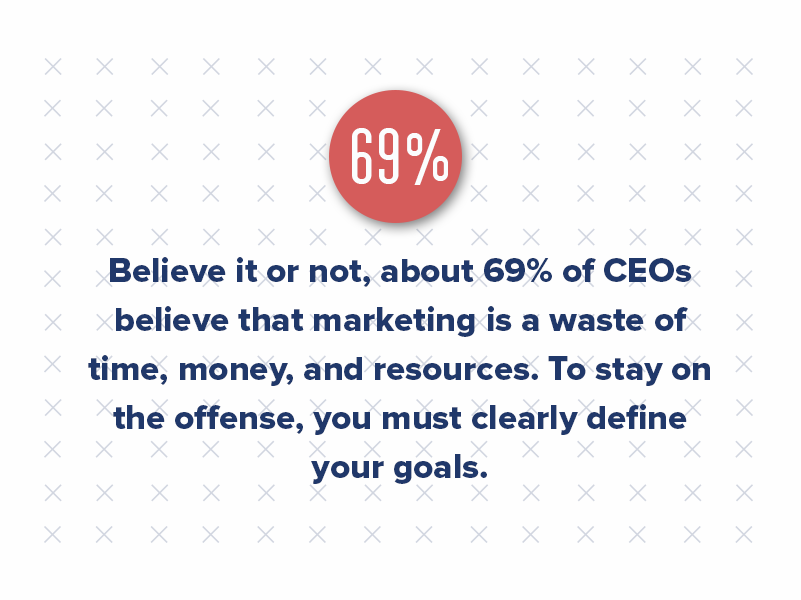
3. Always go after the 3 Hs.
- Head – Explain your plan of action. Defend your strategies with case studies, numbers, etc. Win over your team with proof!
- Heart – If people aren’t truly vested in your idea with their heart, you will lose them. Find out what’s important to them and how to tie your new goals to theirs.
- Hands – Now that you’ve won over your team, you’ve got to get them to get back to (or start) work! Play out those call-to-actions.
4. Prepare to show your medal.
In business, you will fight many battles. You will be criticized and put through the wringer. But, at the end, these obstacles will refine your character — just like a medal has to go through fire to be reshaped and altered.
Take risks and be the change that will keep your organization moving forward.

Why Video Is Important for Your Apartment SEO
As technology continues to improve and become more ingrained into our daily lives, video has taken the main stage. Platforms like TikTok have made binging short, quick videos easy for anyone with a smartphone. YouTube countered this with its feature called “YouTube Shorts.”

However, video isn’t just for show. There are fundamental benefits that videos add to your apartment SEO efforts. Not everyone is energized by recording videos of themselves for their properties. However, these may inspire you to reconsider an SEO video marketing strategy.
Local Geodata of Videos
Similar to photos you take from your smartphone, videos capture embedded and local geodata within the files. For example, Brotherly Love Real Estate, a homebuyer starting in Philadelphia, PA, expanded to the west coast. They began their SEO video marketing efforts in Southern California, utilizing videos to help increase their rankings.
Brotherly Love Real Estate went to each city they wanted to rank in, recorded a video, posted it directly to YouTube, and placed it on their respective website pages. This website shows how they now buy and sell houses in San Diego from the success of their videos.
The geodata gets stored in the video file through location-identifying features from the smartphone. Google recognizes that, allowing it to carry weight when considering which multifamily website to rank for certain local search terms. It can feel tedious at times to record videos and then upload them. However, the results can be worth pursuing.
Increases Time on Page Through SEO Blog Writing
Another ranking factor that Google considers when determining which websites to show for a certain query is time on page. The more real, local users spend on your multifamily website, the more authoritative Google will consider you. They assume that if people spend tons of time reading through multiple pages or posts on your site, you must know what you’re talking about. Your content is viewed as credible, trusted, and rank-worthy.
Adding a video to your pages and posts is a great SEO video marketing strategy to encourage users to linger on your pages for longer. Over time, this will boost your apartment SEO. It also makes your SEO blog writing more robust.
Certain people prefer to learn audibly or visually. For these types of people, videos are sometimes preferred over long blogs full of text. Videos will add a different channel for your users to consume your content and get value from it.
Provide Additional Web Traffic
Google likes to see traffic from different channels (sources). For example, if your property website gets traffic from Google search, Twitter, and Pinterest, it will assume you are a more legitimate business than others that only get Google search traffic. This shows Google that people find you from different areas of the internet, which is a good sign. You can show traffic through your videos on both YouTube and TikTok. This will help boost your apartment SEO efforts.
Additionally, the more traffic you get to your site, the more other apartment SEO metrics can increase. Users can find you through YouTube and then begin crawling your property website. Your time on page for certain pages can increase.
Ideally, you can create a naturally flowing funnel for users to continue watching your videos. They can hop from YouTube into your property website through a link in the video description. From there, they can start exploring the other videos on your website’s different pages.
Shows Legitimacy
The more places you are around the internet, the more trustworthy you appear to search engines. If you have a large following of subscribers on YouTube or TikTok, that carries weight with your rankings. You are viewed as an authority in the online space regarding certain topics.
Your brand also appears more legitimate to the renters surfing your property website. For example, showing your face to potential apartment leads on your site will add credibility to your multifamily brand. They will naturally feel more comfortable with your apartment communities if a more personal connection is made through your SEO video marketing.
Users will be encouraged to continue crawling your website if they trust you. A high bounce rate is a negative factor to search engines. Bridging the gap of personal connection between your property brand and your users will decrease the number of people that bounce directly after hopping on to your site.
Videos encourage people to continue browsing other areas within your site, thus making it easier to get more prospective renters on your pages and convert them. SEO video marketing will only increase in popularity as we head into the future. You must keep up with this trend and use it to your property’s advantage.
Jenn is an experienced writer for the real estate industry and a house flipper for We Buy Houses in Denver. If she’s not swinging a hammer, she’s either writing about different real estate topics or reviewing investment property opportunities.
Who Should Be in Charge of Social Media for Apartments?
By now, we’ve established that social media is another platform for communication.
Renters want information anytime, anywhere, and they want it at their fingertips. Their need for information is instantaneous, and social media for apartments is the only marketing source to deliver that.
Residents are increasingly connecting with properties online throughout all phases of the renting process, from research to retention. As a result, property managers need to be able to do their jobs online, requiring them to have a certain amount of autonomy. Social media for apartments presents several opportunities for leasing, multifamily marketing, and building relationships. However, it also presents many risks.
A Balancing Act Between Corporate and Property-Level Marketing
Online word of mouth and one bad resident experience can taint an apartment brand. Property managers (not just corporate) must be present, helpful, and interactive on social media to read, respond, and act on any negative resident feedback.
It’s natural for corporate management to want complete control over their properties’ online activity, as doing so would limit risk and maintain consistent apartment brand messaging across all properties. However, this isn’t realistic.
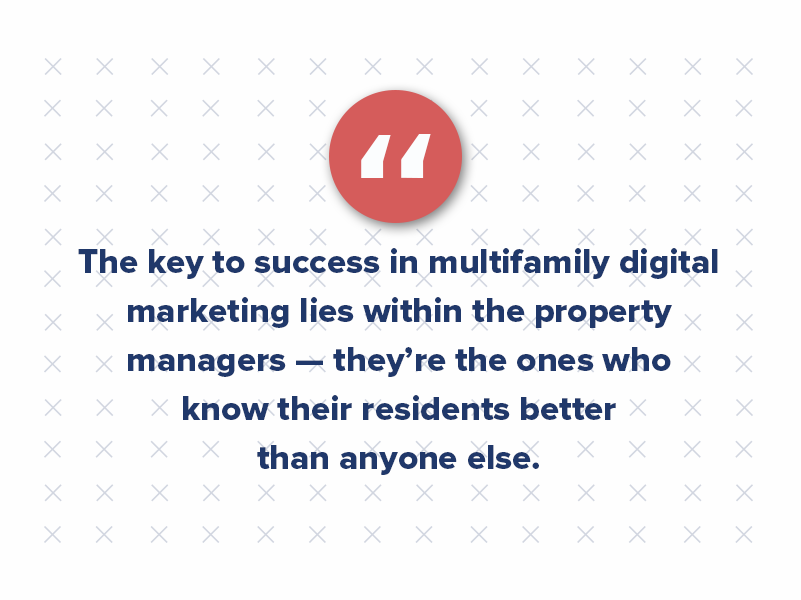
The key to success in multifamily digital marketing lies within the property managers — they’re the ones who know their residents better than anyone else. They live and work in the communities they serve, and they’re the ones interacting with residents daily.
So, how do we balance apartment brand consistency (corporate level) and local content/personalized service (property level)? The answer is quite simple. It just calls for a little training and education.
Corporate Responsibility: Training
Resident interactions on social media must be handled at the property level. Corporate management needs to take the necessary steps to train property managers. They need to provide resources (e.g., content guidelines, tone), that property managers can customize according to their residents. Employees should feel empowered to communicate on social media — that is corporate’s responsibility.
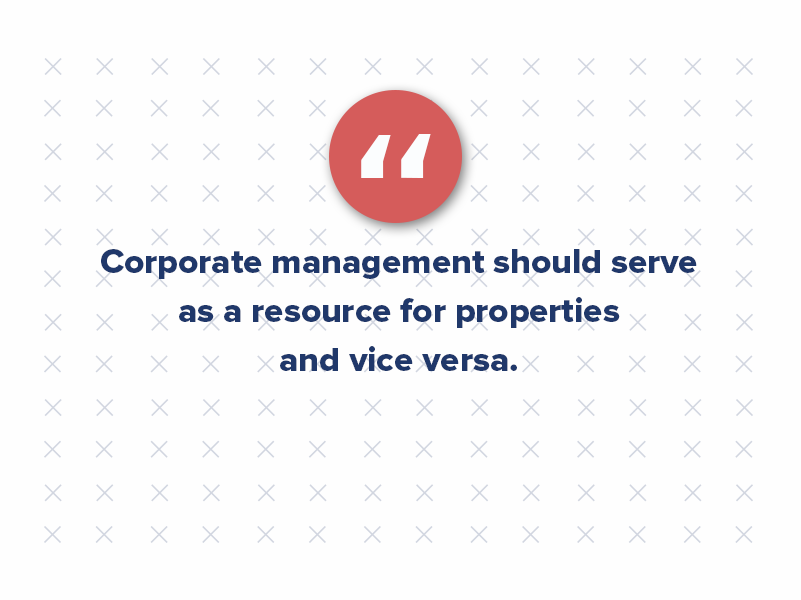
We recommend providing your properties with standard corporate messaging via a “Voice and Tone Guide” for social media and all content marketing, allowing each property to personalize its content.
Focus on keeping messaging simple and consistent. By providing guidelines for use, you can strengthen corporate apartment branding across all properties while allowing local social media to take the shape of its own at the property level.
The most important thing to remember is that corporate training should be ongoing. Organizations like the National Apartment Association (NAA) make that easy for corporate management to implement.
The NAA Education Institute offers the National Apartment Leasing Professional Program. The course includes six modules, which corporate management can license and provide for employees, either online or in the classroom. The curriculum includes everything from monitoring your online reputation to optimizing content for search engines.
Property Responsibility: Open Communication
Successful training requires an earnest effort from each property and its employees. Without their commitment, an effective digital marketing strategy is impossible to implement.
The property manager must consult their regional or national corporate representative anytime they have questions, feedback, or insight regarding social media use.
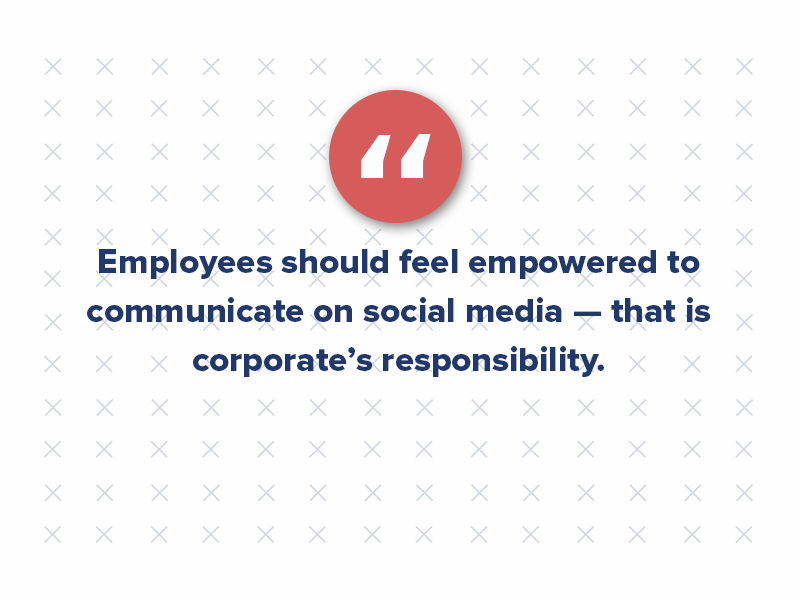
Corporate management should serve as a resource for properties and vice versa. Property managers should provide feedback on local apartment marketing efforts (What works, what doesn’t?). They should also be able to ask corporate representatives for help in unfamiliar situations and provide them with insights from their resident community.
Open communication is the key to balancing strong apartment brand messaging on social media with local personality and service.
Tying It All Together
To sum it up, here are some common threads in establishing multifamily brand development and character: A customer-centric approach is essential to the success of any multifamily digital marketing effort, whether that’s differentiating your property, meeting millennial expectations, designing your multifamily website, and so on. The most successful properties are capitalizing on the relationship-building attributes of social media for apartments and intercepting prospective renters in the places they’re already searching.
Technology is fast-changing the apartment marketing environment, and it’s up to you to respond or risk falling behind.
Why You Should Invest in Professional Multifamily Branding Services
Multifamily branding is not just a “destination.” But it’s also not just a “journey.”
We’ve said it before, and we’ll say it again: multifamily branding involves way more than an apartment logo or flowery brochure.
It’s about telling a brand story that resonates with your residents, building a brand identity that stands the test of time, and creating an honest brand from the inside out that your residents and prospects will trust.
If you want to be on the right side of multifamily branding, you need to invest in the services of a professional multifamily branding agency.
Hiring a top-tier multifamily branding agency can be stressful. We know from our clients that deciding to bring on an outside agency in the first place — let alone deciding which one to hire — is a big decision.
First, it’s a marketing cost you might not have included in the initial budget. Secondly, shifting work on something as integral to a property as its multifamily brand raises fear of losing control to a team not in your property management office.
Key to making a case for hiring a multifamily branding agency is recognizing that an agency with the right experience and creativity will help generate more apartment leads in the long run and can be one of the most important investments you make.
Here are a few more reasons why hiring our multifamily branding agency to take you on this branding adventure (or “brand-venture,” if you will) could be the best decision you’ve ever made for your property:
1. We’re truly passionate about multifamily.
Criterion.B is a digital marketing and branding agency specializing in the multifamily industry. We got our name in 2017; however, our story began nine years earlier in 2008. Known as Canonball Creative at the time, we started as a digital agency serving ad agencies. Digital marketing was starting to take off, and the larger agencies needed help navigating the market. This provided us with invaluable experience as we worked on some of the world’s largest brands, including Coca-Cola, McDonald’s, Samsung, and Pepsi, to name a few.
We specialized in building out difficult online assets in a way that would stay true to the agencies’ rigid creative guidelines. By 2014, we had already worked with a few big names in the multifamily market, such as Amli and UDR, due to the relationships we made through our ad agency connections. Then, we decided to pivot into building our direct client base focusing on multifamily.
Over the next few years, we invested heavily in the multifamily industry. We attended every conference we could find, joined associations, wrote for as many association publications as we could, interviewed key marketing professionals on the client side, and wrote hundreds of blogs focused on multifamily marketing.
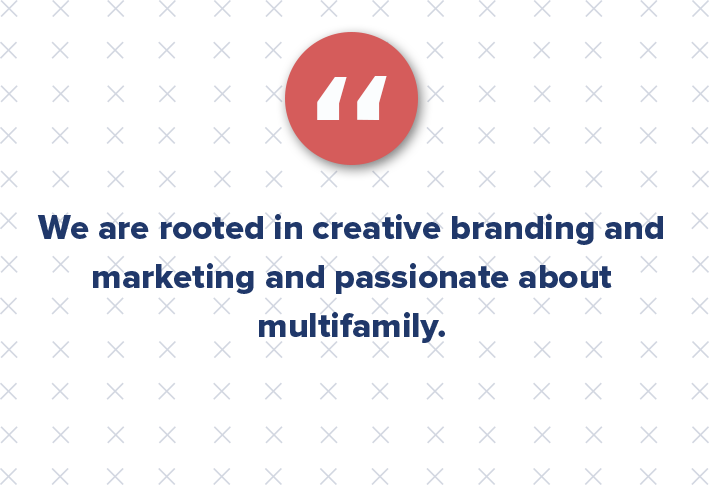
In 2017, we made it official by changing our business name to Criterion.B and pivoting our focus entirely to serving the multifamily market.
In short: We are rooted in creative branding and marketing and passionate about multifamily. The perfect pairing makes us the perfect partner for your property.
2. We’re backed by the best clients.
Whether you need marketing collateral designed and printed, new swag for your property, or a full brand development package, our multifamily branding agency is ready to serve as an extension of your team to ensure consistency and positive results.
We don’t work for our clients; we work with them to create an honest, recognizable, and beautiful brand from the ground up.
Take NE Development as one example. NE Development is a premier multifamily developer in the North Dallas area. Their high-rise project in Dallas’ exploding Legacy West area, LVL 29, offers luxury living. Criterion.B has worked with NE Development from the early phases of the project to the high-rise coming online in early 2019 — through to today.
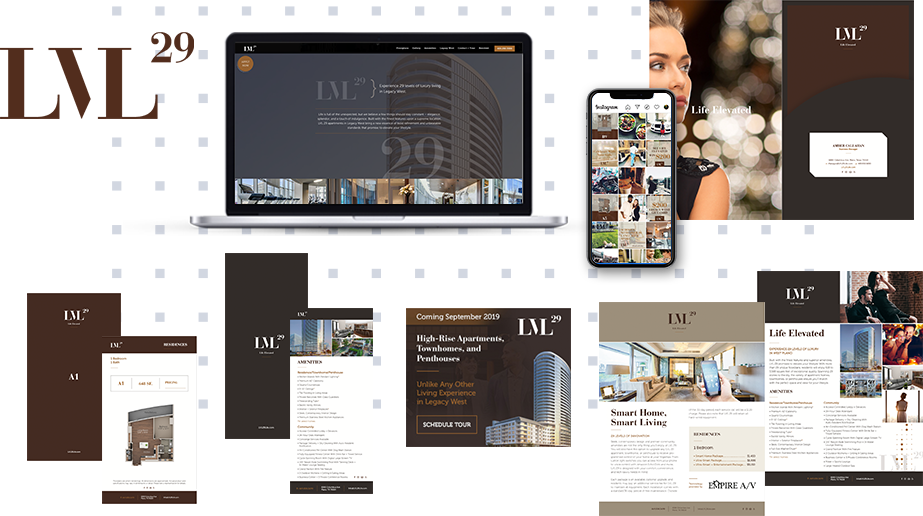
Our multifamily branding agency was tasked with helping NE Development inspire elegance, splendor, and a touch of indulgence in all brand elements of LVL 29, from naming and brand development to website, collateral, social media management, and signage design.
Criterion.B has worked with the LVL 29 team from groundbreaking and development to lease-up and beyond. From building the brand elements to managing social media content, we continue to help LVL 29 grow to new heights — and it all started with building a bold brand.
3. We offer more than just one-off multifamily branding projects.
Are you looking for a jack-of-all-trades agency that specializes in precisely what your property needs? You’ve come to the right place.
We know that a great brand and name is recognizable, unique, meaningful, and can stand the test of time; it goes beyond just the apartment logo stamped across promotional items. Through research and brand strategy, we help build a multifamily brand that connects with your customers.
At Criterion.B, we take your mission, vision, and goals and translate them into a design that will fuel the direction and growth of your new property. Investing time into developing your multifamily brand will align your internal and external audiences and drive tangible results to your bottom line.
Here is a quick snapshot of the multifamily branding services we offer:
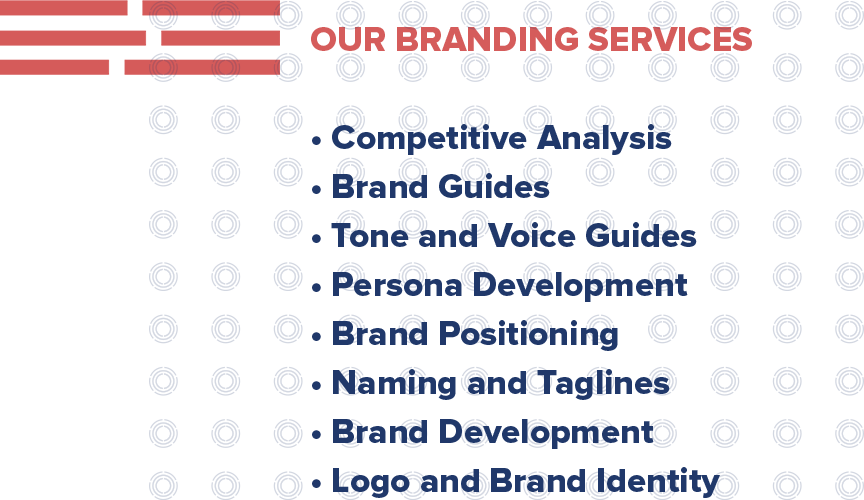
4. We bring 100 years of combined experience to the table.
A passionate team of creative professionals backs our multifamily marketing agency. We specialize in multifamily branding new developments from the ground up. Ultimately, we believe in building your brand into one that residents can trust and love.
We’ve seen a thing or two as professional marketers with more than 100 years of combined experience. We know what makes your organization tick and the best branding elements to edge out the competition. We are passionate about creating a brand that exceeds your expectations (and ultimately your goals) because your success is our success.
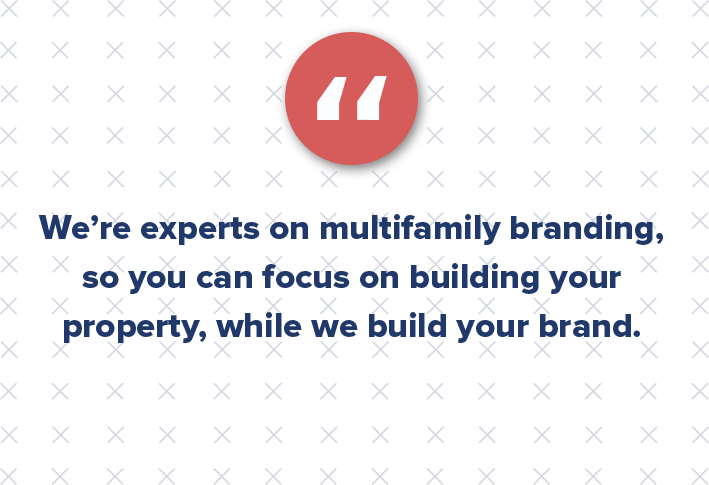
Essentially, we’re experts on multifamily branding, so you can focus on building your property (and leases), while we build your brand. No muss, no fuss, no hassle!
5. We understand that branding is about the journey AND the destination.
At Criterion.B, we maximize the multifamily branding potential of your real estate portfolio — whether as a developer, investor, owner, or property management company. Our passion is to blend restless creativity with remarkable multifamily branding to drive awareness and apartment leads to your property.
We’re here for you with anything you need — whether that be branding and marketing help, printing, or even just a friend to brainstorm ideas with.
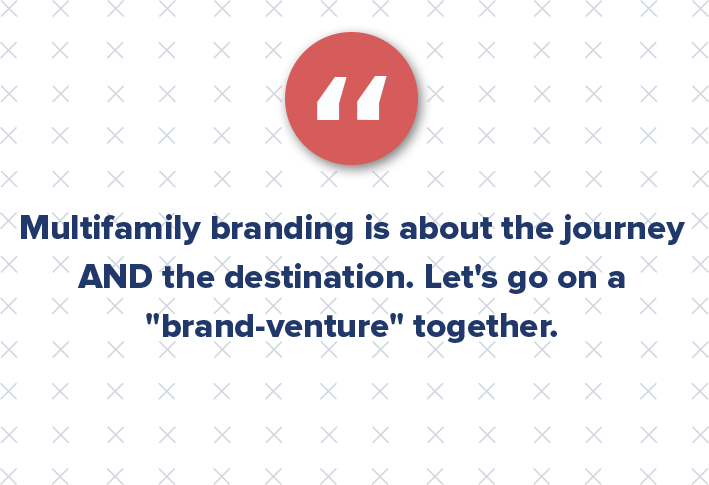
Building a multifamily brand is a journey that must be traveled (no matter how complex it may be), and we were built for this adventure.
How Do You Measure Success in Social Media?
When it comes to proving the value of a digital multifamily marketing strategy, return on investment (ROI) is the keyword all executives want to hear. It may seem a simple enough request, but calculating social media ROI can get pretty tricky.
While social media ROI is definitely important, there’s a different way to think about ROI that’s critical for marketers; the foundation that a strong initial multifamily marketing strategy can provide for all future multifamily marketing endeavors.
While it may seem minimal compared to the numerical value that a multifamily marketing strategy can provide a company, it’s important to remember that the work done in an initial strategy can make or break any future marketing efforts.

Our 7+ Years of Multifamily Marketing Expertise in Your Inbox. Weekly.
Why Strategy Lays Important Groundwork
It’s easy to espouse demographic information about a brand. For example, most Oreos purchasers are parents between the ages of 24 and 39. But what does that information mean? This explains a core distinction between digital marketing strategy vs. traditional marketing efforts.
For traditional marketing, this information is simple enough for Nabisco to put out a commercial during daytime hours for stay-at-home parents that heavily features children enjoying Oreos.
For digital marketing, the approach is more complex. From this demographic information, what do we know about these parents? Where do they spend their time online? What does their buyer’s journey look like? What is a deciding factor in their purchase?
As Oreo is an established brand with years of name recognition under its belt, it’s unlikely that it would have to consider these factors to find marketing success seriously. For other companies entering the world of digital marketing, this information is “make or break.”
Knowing the important factors of your digital multifamily marketing strategy is important in your first campaign and campaigns developed down the road. Not addressing this information upfront could lead to catastrophe, forcing marketers to return to step one.

Stay Updated With New Multifamily Marketing Content
Multifamily Marketing By the Numbers
For multifamily marketers, content marketing can take time to show real results. That being said, it’s a long-term approach that improves your brand’s visibility online and helps you nurture stronger customer relationships.
While it can be difficult to assign a dollar value to marketing ROI or ROMI (Return on Marginal Investment), numbers are still important to the marketer, more focused on marketing and results than the value of the marketing.
Consider the following statistics to understand the value behind marketing beyond ROI further:
- Companies that blog 15 or more times per month see 5x more traffic than companies that don’t blog.
- 82% of businesses report actively using content marketing, up from 70% last year.
- Marketers with blogs receive 67% more leads than those who don’t.
- Marketers who prioritize blogs are 13x more likely to have a positive ROI.
- Video content is 50x more likely to drive web traffic than plain text.
- Using photos of real people rather than stock photography can result in a 35% conversion increase.
- Video was the primary form of marketing media created in 2021, followed by blogs (used by more than half of marketing teams), and infographics.
- Social engagement as a success metric was also on the rise, up 187% from 2020.
These statistics are developed from analyzing a widespread amount of marketing data and are incredibly important as marketers decide what tactics work well for their strategy. For example, knowing that blogging daily can have a large effect on the chances of customer acquisition is helpful. It may lead to a heavier blog focus in a group’s digital multifamily marketing strategy. But if persona research suggests that the key personas won’t read a blog, it might be wiser for the strategy to put less emphasis on blogging.
While marketing statistics don’t guarantee that a tactic will work for all marketers, they allow us to see important trends. Though innovation is important in multifamily marketing, it’s also vital that you’re not constantly seeking to reinvent the wheel. By utilizing trusted statistics, marketers can make educated decisions about the tactics to funnel their efforts.

How to Plan Your Next Inbound Campaign for More Renters
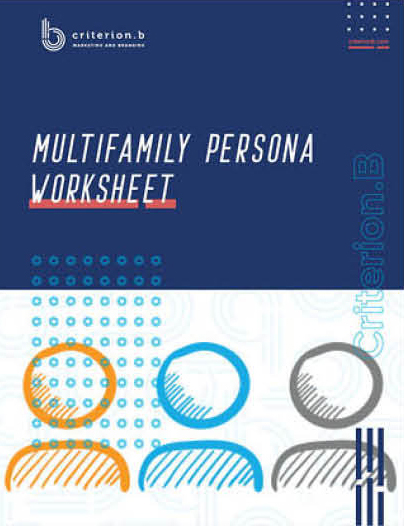
How Companies Are Rethinking the Value of Social Media
Social media reigns supreme in the marketing space, even above multifamily websites. Last year, a website was the No. 1 marketing channel for business. This year, social media is the top dog. In fact, it’s at an all-time high.
What does this mean for your multifamily organization? If you aren’t on social media in some capacity, you are already behind and missing out on qualified leads.
Did you know that 8 in 10 companies invested in social media marketing in 2021, and 39% plan to invest this year? Over the last year, companies had to rethink their strategies and some even hired customer experience officers to help lead the charge in this realm.

The Easiest Way to Determine Your Target Renter
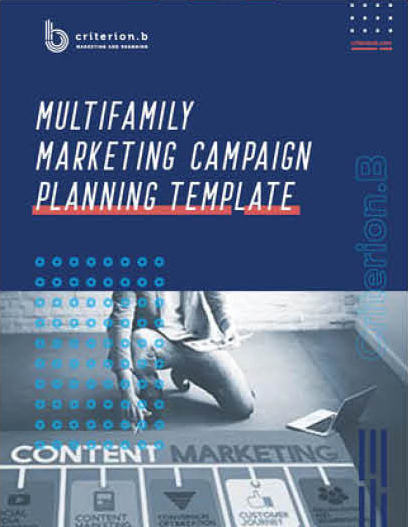
But how do you measure success on social media? Engagement metrics are helpful to track, but how does that translate to conversions and social media ROI? The primary tactic for social media marketing in 2021 was listening — something that will continue into 2022 and beyond.
The true value of social media lies in the relationships you make. By establishing relationships with your followers, you can learn how to engage with them, support them, and — most importantly — convert them into sales and loyal brand advocates.
While the most popular platform for marketers is Instagram, many teams are starting to see the most social media ROI and conversions from Facebook. This is likely due to Facebook’s robust advertising platform and ability to run lead-form ads. While listening to social media is critical to your marketing strategy, you can still achieve social media ROI with lead-form ads and an effective Facebook advertising strategy.
Assigning Value to Your Marketing Efforts
Assigning value to marketing efforts doesn’t have to be solely numerical. Instead, it’s important for marketers to understand that marketing strategy offers an important starting point to all future endeavors. A digital multifamily marketing strategy also offers social media ROI that is not necessarily easily measured but impactful.

3 Keys to Multifamily Branding That Attracts Renters
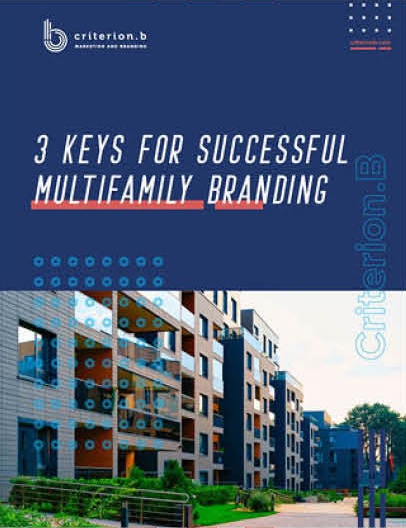
Despite the economic tribulations brought on the U.S. in the last few years, the real estate industry is hot. Aside from the increasing demand for more homes and commercial spaces, the multifamily industry is expected to grow remarkably up until 2030. So, how can you harness some of this data in your multifamily content marketing?
Let’s discuss …

A report from the National Multifamily Housing Council (NHMC) and the National Apartment Association (NAA) states that demand for multifamily real estate will be so great that at least 4.6 million units will be constructed within the next decade.
However, to make the most of these promising forecasts, multifamily real estate companies must learn to optimize data when creating multifamily content marketing.
Why Data Is Crucial in the Multifamily Industry
Data is crucial in every industry as it can improve conversion rates, increase traffic, and prevent knowledge gaps. To illustrate, a Bain & Company study states that businesses in the U.S. could increase profits by over $2 billion annually by utilizing data. Thus, data literacy is integral to professionals — including those who don’t work in the data analytics field.
In fact, today’s business degrees are becoming more interdisciplinary, covering topics like contemporary technologies and data methods. Modern online bachelor’s in business administration even have concentrations in data analytics and management information systems, which are taught alongside traditional business concepts, such as accounting, management, and business law. This shift only shows the growing expectations placed upon business people to be more data literate.
And this translates to the multifamily industry as harnessing data effectively can lead to more intimate understandings when it comes to trends, more accurate insights into future movements, and more effective multifamily content marketing creation.
How to Integrate Data Into Your Multifamily Content Marketing Strategy
1. Use data to drive contextual storytelling.
Good communication should paint a vivid picture, even if the topic is technical. After all, consumers need to understand the material for it to be impactful. However, multifamily marketing campaigns must also present information that audiences can relate to or find use in to have a lingering effect. This is where gathered data comes in. Using soft and hard data, you can create a well-rounded customer story that provides context, evidence, and insights. Thus, when crafting multifamily content marketing for your customer story, use data collaborations to maximize relevancy.
2. Leverage data visualizations.
Nothing hypes an exciting data set more than visuals. Though some data diehards may disagree, the truth is that visualizations make data more appealing and digestible. In fact, a study by iScribblers found that humans process visuals 60,000 times faster than plain text. Thus, should you have any pertinent data that needs sharing, explore doing so via infographics, interactive tables, or even videos.
Aside from being more immersive and interactive, data visualizations can increase recall value by upwards of 65%, making it a critical medium in data dissemination, externally and internally.

3. Only pick the most salient data points.
Although publishing every bit of data you gather may be tempting, the best way to share them is to circulate the most notable highlights in your multifamily content marketing. This benefits you two-fold. First, more succinct datasets allow you to retain an audience’s attention span (only eight seconds). And, second, shorter data — and content, in general — is more digitally compatible.
Considering that mobile compatibility and software development is credited by 59% of those in the multifamily industry for improving customer service, it’s also no surprise that there is now a demand for software programmers with a degree in computer science. However, whatever platform you use, your audience won’t be engaged if you present them with a hodgepodge of figures and statistics.
In line with this, data expert Dr. Stephanie Evergreen told Forbes that “cutting to the chase” with your findings is a better way to engage the 50% of audiences who view such content on their mobile devices.
Although experts agree that the real estate market’s long-term future remains unclear, the influence of multifamily content marketing and the power of data is undeniable. As multifamily businesses aim to adjust to the New Normal, data-enriched content can act as an anchor and a propeller for industry stability and profit.
Selena Perkins is a freelance digital marketer, with a keen interest in data analytics. She believes that knowing how to use data to make decisions is a must-have skill for everyone. When she’s not busy with work, Selena unwinds by watching shows on Netflix.

Technology moves fast, as do digital marketing trends. As we live and breathe commercial real estate at our multifamily marketing agency, we understand where the industry is headed.
The following is our breakdown of the current trends in social media, augmented reality, and more — plus where we think the multifamily marketing space is headed in the future.

1. Content still reigns king.
Content marketing certainly is not a new concept and it certainly is not going out of style. By now, most companies know they need to create content that engages prospective customers. However, the question is how to do it more effectively. As the year continues, we will see commercial real estate companies creating more meaningful content than ever before.

As the commercial real estate industry turns to content marketing, the smart ones will be more targeted. The key here is that you don’t need a thousand views per blog. Rather, you only need your target audience to view your content. Once you segment your audience base properly, you can launch individualized advertising campaigns and target those segments specifically. This approach will help you gain more apartment leads and conversions from these retargeting ads.
Truthfully, there’s no way around this. The success of your digital multifamily marketing campaigns will depend on your use of originally created, high-quality custom content — as content continues to reign in the realm of digital apartment marketing.
2. You need to pay to play.
Now is the time to focus your efforts on paid social media apartment marketing. The organic reach across most social media platforms is dying. By investing in paid social media apartment marketing you will increase your engagement and get high organic reach, as well as better search marketing.
With paid social media multifamily marketing, almost all social media networks will give you clear metrics to measure your performance and ROI. Another benefit to utilizing paid social media marketing is the ability to reach completely new target customers and enhance your apartment lead generation. By paying to promote your post, you increase the chances that people might share your content or engage with your organization.
3. Social media for apartments is where it’s at.
Social media has come a long way since its early days of simply sending a message, selfies, or favorite links. It has matured enough to become an effective tool in digital multifamily marketing for engaging with targeted customers on an interactive channel. However, oftentimes those in commercial real estate forget to actually be social on social media.

Unfortunately, many property professionals do not take advantage of social media for apartments. Many times, they don’t reply to the influx of messages on social media. They also don’t maintain a frequent presence or put marketing dollars behind campaigns. Social media is an untapped market for properties to set themselves apart from the rest and can be the difference between turning a prospect into an apartment lead.

4. Instant messaging and chatbots are game changers.
Connectivity is another great advantage of social media. The simple ease of using functions such as direct messaging makes it easier than ever to engage with your residents. However, the conundrum that property managers now face is how to respond fast enough and accurately to prospective residents.
Cue multifamily marketing automation bots, also known as chatbots.
Today’s consumers want to engage with a company when and where it’s most convenient for them. For real estate, this could mean losing possible apartment leads if we are not able to respond to needs instantly. Chatbots seem to have cracked the code, quite literally, on instant communication. According to Botpress, a chatbot is defined as “any software that performs an automated task … the most intuitive definition is that a bot is a software that can have a conversation with a human.”

In addition to being programmed to have realistic, human-like conversations with prospective clients, chatbots are also able to gather specific information relevant to the seller or the marketer.
In the context of commercial real estate marketing, a chatbot can mean providing 24/7, instant responses that do not require an individual behind a screen scrambling to answer a question. Chatbots also provide a smoother user experience for the resident, and user experience is always critical.
5. You need to utilize live video to increase engagement.
Video’s popularity as a multifamily marketing medium continues to grow yearly, and this year is no different. Particularly, live video is where we see social media platforms migrating. Live video contains much more engagement and fares better with many social media algorithms. More and more companies in commercial real estate are recognizing the power of video as a digital multifamily marketing strategy.
There are huge opportunities for leasing agents to really innovate and get away from traditional apartment marketing by utilizing Facebook Live to conduct virtual tours or answer real-time questions. Likewise, property managers can get in on the fun, as they may use Snapchat or Instagram Stories as a way to engage with current residents and alert them to fun events.
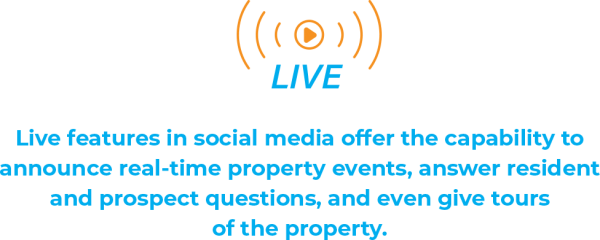
6. It’s time to embrace virtual real estate.
Where do we see the future of multifamily marketing efforts? Virtual and augmented reality. As our industry rapidly embraces technological innovations, integrating VR and AR can set you apart from competitors.
Implementing VR elements into your apartment marketing scheme can prove effective when done correctly. Virtual reality opens the door to prospective clients that may have otherwise not been able to see your property, as they digitally tour units and enter a lifelike simulation of your multifamily property. Moving forward, we see this trend taking off as we can expect more and more companies to design 3D commercial real estate models through virtual reality.
Augmented reality is used by multifamily industry thought leaders today. It brings blueprints to life by taking a traditional flat layout and turning it into a lifelike 3D model. AR will provide a unique opportunity at every level of commercial real estate as it continues to evolve. Professionals believe that AR provides great value at the early stages of a construction project, and at the final stages of selling and multifamily marketing.

7. Drones can set your multifamily marketing apart.
Drones are a defining piece of technology for commercial real estate. Just a few years ago, it was conventional to hire a professional photographer for aerial shots of a property. Sellers now are capable of capturing stunning images and breathtaking videos of their property with camera-equipped drones, all while cutting back on costs.

Drones can depict a great layout of the entire property, especially when recording video. For larger areas, the unique benefit that drones provide is navigation beyond the property and into the surrounding area. They are able to capture incredible bodies of water, beautiful landscapes, and nearby neighborhoods. This particular feature can be optimized if paired creatively with live streaming.
Drones also allow high-rise offices to capture images of the entire building along with attractive neighboring hotspots. Drones are one trend guaranteed to set your marketing apart from competitors, and will surely spread within the commercial real estate industry.
What does all of this mean for multifamily marketing?
It’s a game-changing year for apartment marketing, especially in terms of how to reach prospective buyers in your area. Up until now, the marketing landscape has remained more or less the same, with social media for apartments claiming the throne in every corner of influence. However, we are now seeing increasingly fast-paced developments in the form of new and updated features such as live streaming and instant messaging.
What does all of this mean for multifamily marketing? Put simply, it means that content will have to be creative and engaging in order to gain more activity online. Are you ready to get creative?





